Introduction to ‘Birth and the early days’
In this sprint you will develop the following knowledge:
- I can help parents understand the development capabilities of their baby to increase the likelihood of appropriate expectations and high quality interactions.
- I can explain the benefits of skin to skin to caregivers following birth.
- I can promote the communication and bonding between a parent and baby through voice, touch and smell.

Each child’s level of development can vary depending on their environment. We’re now going to look at some guidance which parents can use to understand children’s capabilities.

Read: What to expect, when?
www.eyalliance.org.uk
- Read through the guide below for parents about child development to help develop your understanding of children’s capabilities.
- It is split into the age ranges as shown below.
- Each section includes things children might be able to do followed by how adults can support children’s learning.
Develop your understanding of ‘Birth and the early days’

Read:
There is a growing body of evidence that skin-to-skin contact after the birth helps babies and their mothers.
Select each of the hotspots in the image below to find out more.
Image by Freepik
Skin-to-skin contact also provides the following benefits for babies in the neonatal unit.:
- improves oxygen saturation
- reduces cortisol (stress) levels, particularly following painful procedures
- encourages pre-feeding behaviour
- assists with growth
- may reduce hospital stay
- improves milk volume if the mother expresses following a period of skin-to-skin contact, with the expressed milk containing the most up-to-date antibodies.

Watch: Meeting baby for the first time
Unicef UK Baby Friendly Initiative
Watch the video below to learn about the theory and practice of skin-to-skin. Make notes about the benefits of skin to skin.
Reflect upon ‘Birth and the early days’
You have thought about babies capabilities and how their development might be supported and you have explored the benefits of skin of skin contact.

Read: Supermum, superwife, supereverything: performing femininity in the transition to motherhood
<undefined></undefined>
P. Choi , C. Henshaw , S. Baker & J. Tree (2005) Supermum, superwife, supereverything: performing femininity in the transition to motherhood, Journal of Reproductive and Infant Psychology, 23:2, 167-180, DOI: 10.1080/02646830500129487
Use the article below and the questions underneath to help you think critically about the role of motherhood.
Page 2 – The aim of this qualitative study was to comprehend how mothers understood and accounted for their experiences in relation to the ideology of motherhood which has been socially constructed as a critical aspect of femininity.
- What does the above sentence mean?
- What is ideology? Why is ideology important in relation to motherhood?
- What does socially constructed mean? Why is socially constructed important to motherhood?
Page 2 – two higher order themes are presented: ‘the realization of new motherhood’ and ‘coping with new motherhood’. These themes demonstrate how unprepared for motherhood the women were and how their expectations were based on various myths of motherhood.
- How might myths about motherhood affect parents?
- What might influence mothers understanding of motherhood?
Page 2 – This led to feelings of inadequacy as they struggled with the myth versus reality discrepancy. However, they could not be seen to be inadequate and therefore employed greater efforts to portray themselves as supermum, superwife, supereverything and hide the opposite.
- Where do myths about motherhood come from?
- Why is there a myth versus reality scenario?
- Why did they perceive themselves as inadequate?
- Why is there a need to be perceived as supermum, superwife, supereverything?
Page 3 – this research….. contributes to a reconceptualisation of motherhood within a broader socio-political context.
- Why do we need a reconceptualisation of motherhood?
Page 3 – mothers voices have presented a very different picture of motherhood than the cultural representations that depict positive images only. These images come from an ideology of women as natural mothers, immediately able to care for their babies, and ultimately fulfilled in this role of selfless carer and nurturer. The reality of motherhood is very different to the myth, but even with more realistic depictions of motherhood in popular literature and prenatal classes, this ideology remains dominant.
- How do cultural representation and images affect the social construction of ideas?
- What are the implications for motherhood?
Page 3 – Indeed, a number of researchers have documented that women’s expectations of motherhood are influenced by the ideology and, when faced with the reality, have to accept that they cannot meet this ideal which leads to conflict
- What are the implications for mothers who cannot meet the ideal?
Page 3 – This conflict has been associated with depression following childbirth, although the relationship is not straightforward as not all women who experience this conflict will become depressed
- What are the effects on mothers of depression?
Page 4 – Women’s agency, therefore, is in choosing to have a baby as a way of producing a feminine identity as opposed to the notion that women have babies as a result of some natural (i.e. biological) force inherent within them
- What does agency mean?
- What is a feminine identity?
- How are notions of feminism enacted here?
Engaging critically with this journal article will help you explore some of the challenges connected to promoting the communication and bonding between a parent and baby.






